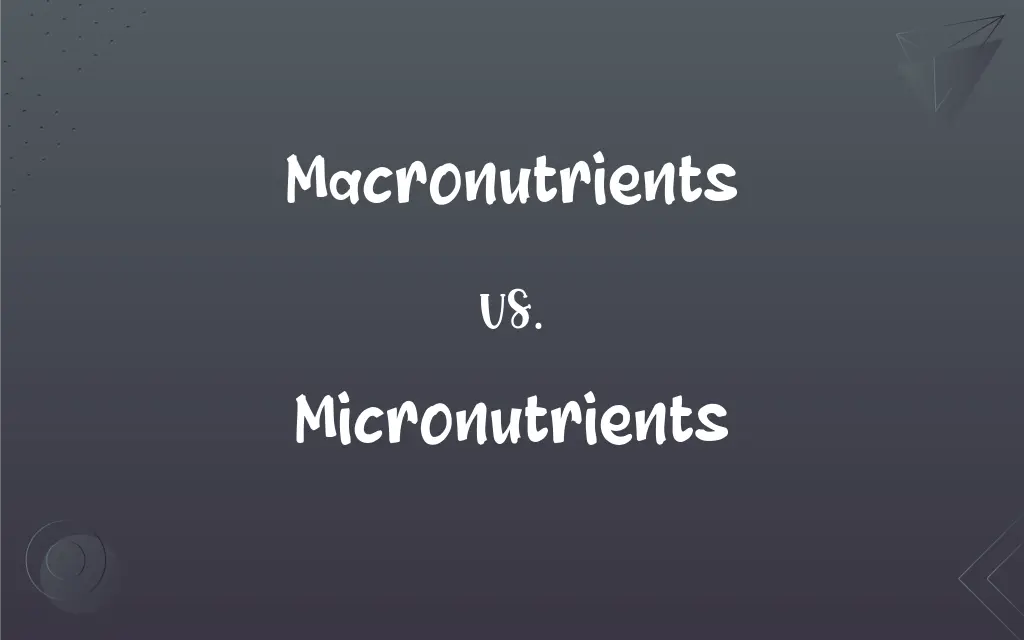Macronutrients vs. Micronutrients: What's the Difference?
Edited by Aimie Carlson || By Harlon Moss || Updated on October 19, 2023
Macronutrients are nutrients required in large quantities (proteins, fats, carbohydrates); micronutrients are vital minerals and vitamins needed in smaller amounts.

Key Differences
Macronutrients and micronutrients are essential for our body's proper function and growth. Macronutrients, comprising proteins, fats, and carbohydrates, provide the energy necessary for our daily activities. Micronutrients, on the other hand, are vitamins and minerals that the body requires in minute amounts to catalyze vital physiological processes.
Consuming an appropriate balance of macronutrients supports overall growth, muscle synthesis, and energy production. Micronutrients, despite being required in lesser quantities, are paramount for enzyme function, bone formation, and the synthesis of molecules vital to life.
While macronutrients fuel our body and form the foundation of our dietary intake, micronutrients play a role in preventing diseases and ensuring well-being. Both macronutrients and micronutrients are indispensable, emphasizing the importance of a diverse and balanced diet.
Macronutrients are the primary sources of calories in our diet. Carbohydrates, for example, are macronutrients that provide four calories per gram. Micronutrients don't provide energy but facilitate the body's utilization of energy and other critical processes.
Every meal we consume ideally combines both macronutrients and micronutrients. For instance, a balanced meal might contain proteins (macronutrients) and essential vitamins like vitamin C (micronutrients).
ADVERTISEMENT
Comparison Chart
Quantity Required
Needed in larger quantities
Required in minute amounts
Examples
Proteins, fats, carbohydrates
Vitamins, minerals
Role in Body
Energy production, muscle synthesis
Enzyme function, disease prevention
Dietary Sources
Meat, dairy, grains, vegetables
Fruits, vegetables, meats, dairy
Caloric Contribution
Primary sources of dietary calories
Do not directly provide energy
ADVERTISEMENT
Macronutrients and Micronutrients Definitions
Macronutrients
Macronutrients are major dietary components.
The body relies on macronutrients for energy and growth.
Micronutrients
Micronutrients are necessary in small amounts.
Though needed in tiny quantities, micronutrients have significant impacts.
Macronutrients
Macronutrients are required in large amounts daily.
Daily diets predominantly consist of macronutrients.
Micronutrients
Micronutrients are vitamins and minerals.
Micronutrients, like vitamin D, are essential for bone health.
Macronutrients
Macronutrients are calorie sources.
When considering calorie intake, focus on macronutrients.
Micronutrients
Micronutrients don't directly provide energy.
Though they don't give energy, micronutrients facilitate energy utilization.
Macronutrients
Macronutrients include proteins, fats, and carbohydrates.
Balancing macronutrients can help maintain a healthy weight.
Micronutrients
Micronutrients support physiological processes.
Iron, a micronutrient, is vital for oxygen transport.
Macronutrients
Macronutrients support physical growth and energy.
Athletes pay close attention to macronutrients to enhance performance.
Micronutrients
Micronutrients are key for prevention and well-being.
Adequate micronutrients can help prevent certain deficiencies and ailments.
Macronutrients
A substance required in relatively large amounts for the normal growth and development of an organism. Macronutrients for animals include fat, carbohydrate, and protein, while for most plants they include chemical elements such as carbon, hydrogen, oxygen, nitrogen, and phosphorus.
Micronutrients
A substance, such as a vitamin or mineral, that is essential in minute amounts for the proper growth and metabolism of a living organism.
Macronutrients
Plural of macronutrient
Micronutrients
Plural of micronutrient
FAQs
What are macronutrients?
Macronutrients are nutrients like proteins, fats, and carbohydrates required in large quantities.
How do micronutrients differ from macronutrients?
While macronutrients provide energy and are needed in larger amounts, micronutrients are vitamins and minerals required in smaller amounts.
Where can I get micronutrients from?
Fruits, vegetables, meats, and dairy are good sources of various micronutrients.
Do micronutrients give us energy?
No, micronutrients don't directly provide energy but aid in energy utilization and other vital processes.
What happens if I lack micronutrients?
Micronutrient deficiencies can result in health problems, ranging from fatigue to severe conditions.
Can I take supplements for macronutrients and micronutrients?
Yes, but it's advisable to consult a healthcare professional before starting supplementation.
Can an excess of micronutrients be harmful?
Absolutely, an overabundance of certain micronutrients can be toxic and detrimental.
How can I ensure a balanced intake of macronutrients?
Consuming diverse foods, and considering individual needs can help ensure a balanced intake.
Are all micronutrients essential?
Yes, even though they are required in small amounts, each micronutrient plays a specific and crucial role.
How do micronutrients support health?
Micronutrients facilitate various physiological functions, from immune support to vision.
Which foods are rich in macronutrients?
Foods like meats, dairy products, grains, and vegetables are rich in macronutrients.
Can I have too much of a macronutrient?
Yes, overconsumption can lead to health issues, like excessive calorie intake from too many carbohydrates.
Which elements classify as micronutrients?
Vitamins like A, C, D, and minerals like zinc, iron, and selenium are micronutrients.
Can an imbalance in macronutrients affect health?
Yes, imbalances can lead to various health issues, including weight gain or malnutrition.
Is it better to get macronutrients and micronutrients from food or supplements?
Ideally, obtaining these nutrients from whole foods is best, but supplements can help in cases of deficiencies or specific needs.
Can you name a few macronutrients?
Yes, carbohydrates, proteins, and fats are primary macronutrients.
Why are macronutrients crucial?
Macronutrients provide energy, support growth, and are foundational in our diet.
How do macronutrients benefit athletes?
Macronutrients support energy production, muscle growth, and recovery, essential for athletic performance.
How are macronutrients metabolized?
Macronutrients are digested and converted into energy or used for bodily functions and growth.
Do micronutrients aid in digestion?
While they don't directly aid in digestion, micronutrients support enzymes and functions related to digestion.
About Author
Written by
Harlon MossHarlon is a seasoned quality moderator and accomplished content writer for Difference Wiki. An alumnus of the prestigious University of California, he earned his degree in Computer Science. Leveraging his academic background, Harlon brings a meticulous and informed perspective to his work, ensuring content accuracy and excellence.
Edited by
Aimie CarlsonAimie Carlson, holding a master's degree in English literature, is a fervent English language enthusiast. She lends her writing talents to Difference Wiki, a prominent website that specializes in comparisons, offering readers insightful analyses that both captivate and inform.






























































